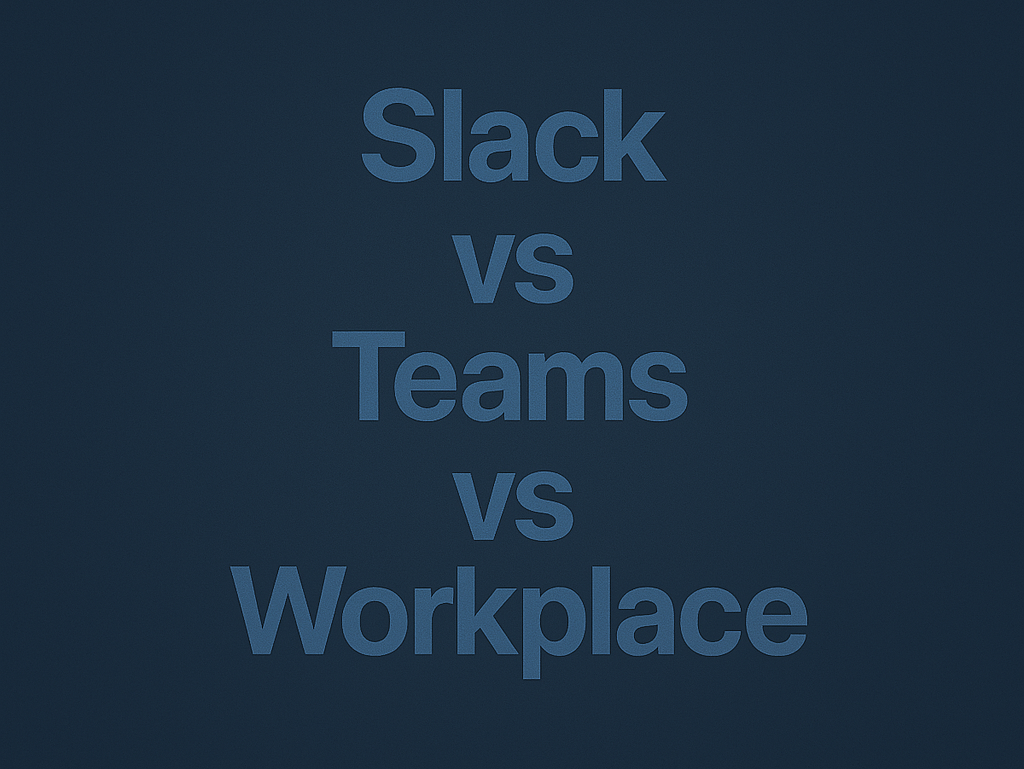In today’s dynamic work environment, choosing the right communication and collaboration platform can be the difference between a highly productive team and one that constantly struggles with miscommunication. This article compares three of the most popular platforms: Slack vs Teams vs Workplace by Meta. Our goal is to offer you a comprehensive, user-focused guide that helps you decide which tool best suits your business or team’s needs, based on real-world usage, not just features.
Contents
Why This Comparison Matters
Most articles ranking on Google for this topic tend to focus heavily on listing features without connecting them to actual user needs. Others lean into surface-level pros and cons without providing deeper context around usability, integration into workflows, user experience, or organization size. This guide closes that gap by analyzing how these tools perform in real work settings—whether you’re a startup founder, remote team manager, or IT decision-maker in a growing enterprise.
1. Overview of the Platforms
Slack
Slack is a messaging-first collaboration app known for its intuitive design, real-time communication, and a vast library of third-party integrations.
- Best for: Agile startups, software development teams, creative agencies.
- Notable Features: Channels, threads, Slackbot, integrations (over 2,400 apps), Slack Connect for external collaboration.
- Weaknesses: Limited built-in productivity tools, can feel chaotic without structure.
Microsoft Teams
Microsoft Teams is a communication and collaboration hub that’s deeply integrated into the Microsoft 365 ecosystem.
- Best for: Enterprises, academic institutions, and any organization already using Microsoft 365.
- Notable Features: Tight Office integration, persistent chat, Teams/Channels, native video conferencing, built-in file storage.
- Weaknesses: Steeper learning curve, UI cluttered for new users.
Workplace from Meta
Workplace is a business communication tool from Meta (Facebook), designed to mirror the familiar social media experience for workplace collaboration.
- Best for: Large teams wanting a Facebook-like interface and a strong internal community.
- Notable Features: Live video broadcasting, News Feed, Groups, integrations with cloud tools, mobile-first design.
- Weaknesses: Less emphasis on structured task management or document collaboration.
2. User Interface and Experience (UI/UX)
- Slack: Clean, customizable, and lightweight. Easy for teams to jump into. However, the volume of messages can be overwhelming without good channel etiquette.
- Teams: Designed more like an enterprise dashboard. Rich functionality, but it can intimidate non-technical users.
- Workplace: Very intuitive for Facebook users, but the social media feel may feel too casual for more formal business settings.
Winner (UX): Slack for small to medium teams; Teams for larger companies with IT onboarding support.
3. Communication Tools
- Slack: Best for real-time messaging. Voice and video calling are available but basic.
- Teams: Robust voice/video meetings, screen sharing, scheduling, and seamless Outlook integration.
- Workplace: Unique in its use of live video broadcasts, but lacks the same level of meeting functionality as Teams.
Winner (Communication): Teams for full meeting solutions; Slack for fast internal communication.
4. Integration and Workflow
- Slack: Outstanding integration ecosystem (Jira, Trello, Google Drive, GitHub, etc.). Custom workflows via Slack apps and bots.
- Teams: Best integration if you’re already on Microsoft 365. Files, meetings, notes, and collaboration live in one environment.
- Workplace: Integrates with tools like Zoom, Google Workspace, and Microsoft, but with more focus on announcements and community building.
Winner (Integration): Slack for diversity; Teams for depth within the Microsoft ecosystem.
5. Security and Admin Controls
- Slack: Offers enterprise-grade security, SSO, data loss prevention, and admin controls, but some tools require the Enterprise Grid.
- Teams: Built with enterprise security at its core—compliance, advanced data protection, and tenant-level controls.
- Workplace: Good on basic security, but lacks the deep compliance features that regulated industries may require.
Winner (Security): Microsoft Teams.
6. Team Culture and Engagement
- Slack: Encourages open communication and informal bonding via emoji reactions, GIFs, and integrations like Donut (for virtual coffee).
- Teams: Focuses more on work-related collaboration. Still supports memes and GIFs, but less culturally ingrained.
- Workplace: Tailored for building company culture—news feeds, polls, celebrations, and live videos foster connection.
Winner (Engagement): Workplace.
7. Pricing Considerations
While exact pricing changes frequently and depend on region, here’s a general view:
- Slack: Tiered plans. The free version has a limited message history.
- Teams: Included with Microsoft 365 subscriptions.
- Workplace: Charges per user. Discounts are available for nonprofits.
Tip: If you’re already paying for Microsoft 365, Teams is the most cost-effective.
Final Verdict: Which Should You Choose?
| Use Case | Best Tool |
|---|---|
| Small, tech-savvy teams that want flexibility and integrations | Slack |
| Mid-to-large organizations using Microsoft tools | Teams |
| Culture-driven companies valuing internal communication and employee engagement | Workplace |
Bottom Line
Choosing between Slack vs Teams vs Workplace isn’t just about comparing features—it’s about matching the tool to your organization’s communication culture, workflow needs, and long-term goals.
If real-time, flexible communication is your top priority, go with Slack. If you want a centralized, secure, and feature-rich hub tied into Office tools, Microsoft Teams wins. If you care most about fostering connection and engagement among employees, Workplace shines.

